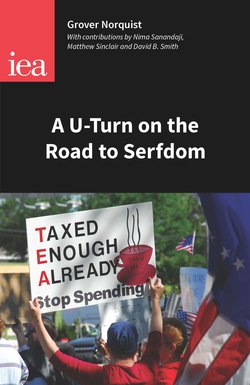Читать книгу A U-Turn on the Road to Serfdom - Grover Norquist Glenn - Страница 11
На сайте Литреса книга снята с продажи.
Reducing spending
ОглавлениеThe second step is to stop spending so much money. One of the failures of George W. Bush’s eight years as president was that he was very good at not raising taxes – but not so good at restraining spending. He had learned the dangers of tax hikes. Bush 43 watched dad raise taxes and lose his bid for re-election in 1992. Dad had been a great president on many things; he managed the collapse of the Soviet Union without a lot of blood on the floor, and kicked Iraq out of Kuwait without getting stuck occupying the place for a decade. There was one problem: he raised taxes. And he threw away a perfectly good presidency as a result.
We did begin to make progress in limiting government spending in 2011. What changed was the arrival of the Tea Party movement. This was a radical change in American politics. It has completed the circle in terms of who sits around the centre-right’s ‘leave us alone’ table.
Before the Tea Party revolt beginning in 2009, most Americans believed that you could not win elections by attacking government overspending. But Americans would organise opposition and win elections once ‘spend too much’ became ‘tax too much’. That was the lesson of the 1978 taxpayer victory of Proposition 13 designed to cut property taxes in California. The California tax increases in the late 1970s were the product of overspending, but the revolt followed the tax hikes not the earlier overspending. Reagan ran for president promising to cut federal spending by $90 billion in 1976 and lost a Republican primary. He won in 1980 and 1984 as the tax cutter. QED. Americans hated tax hikes but not necessarily government spending.
In January 2009, Obama came into power. Within two and a half months, he had threatened to spend trillions – the stimulus and more. The whole point of the stimulus package was to take over $800 billion dollars and throw it in the middle of the ‘takings coalition’ table to keep everybody happy.
This scared Americans, and we had about a million Americans in the streets demonstrating at between 600 and 800 rallies around the United States on the week of 15 April. This was unprecedented. These were not unemployed students. These were men and women with jobs, lives, families. They had never been in a demonstration. And they were not reacting to tax increases – those were yet to come. They were organising in opposition to government spending.
There have been some very good studies about how this affected the voter turnout in places where you had rallies compared with places where they planned a rally, but it rained, so it was cancelled. You could see that we gained between three million and six million voters in 2010 because of increased political activism: the idea of showing up, seeing other people, realising you weren’t alone and that you weren’t crazy was very important.
This was all part of fighting against ‘spend too much’. In November 2010, we elected a great number of people largely on the anti-spending issue. To ‘no new taxes’ the movement added ‘and stop spending so much’. We now have a more internally consistent Reagan Republicanism that opposes tax hikes and spending demands: a focus on reducing spending that buttresses and complements the other ‘leave us alone’ issues.
So, in 2011, when we had the argument between the Republicans in the House and Obama over the debt ceiling increase we were confident we had popular support. We held fast and won. The final agreement did not raise taxes as the Democrats had demanded. Instead we won $2.5 trillion in spending restraint: cuts from planned spending over the decade with real budget caps and a sequester protecting those budget savings.
